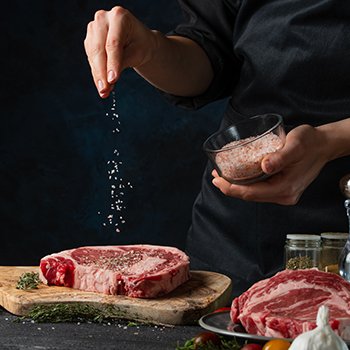นวัตกรรมส่วนผสมสำหรับผลิตภัณฑ์เนื้อสัตว์ที่ดีต่อสุขภาพและดีต่อโลก Non-meat Ingredients: How Innovation Aids in the Development of Healthier Meat Products
284 Views |

นวัตกรรมส่วนผสมสำหรับผลิตภัณฑ์เนื้อสัตว์ที่ดีต่อสุขภาพและดีต่อโลก
Non-meat Ingredients: How Innovation Aids in the Development of Healthier Meat Products
By: ดร. ยุวเรศ มลิลา
Yuwares Malila, Ph.D.
Food Biotechnology Research Team (IFBT)
Functional Ingredients and Food Innovation Research Group
National Center for Genetic Engineering and Biotechnology
Yuwares.mal@biotec.or.th
ผลงานนวัตกรรมด้าน non-meat ingredients เพื่อสุขภาพจากนักวิจัยไทย
จากความต้องการลดปริมาณโซเดียมและฟอสเฟตในผลิตภัณฑ์เนื้อสัตว์ ทางทีมวิจัยจากคณะอุตสาหกรรมเกษตร มหาวิทยาลัยสงขลานครินทร์ ร่วมกับทีมวิจัยเทคโนโลยีชีวภาพทางอาหาร ศูนย์พันธุวิศวกรรมและเทคโนโลยีชีวภาพแห่งชาติ (ศช.) สังกัดสำนักงานพัฒนาวิทยาศาสตร์และเทคโนโลยีแห่งชาติ (สวทช.) ได้พัฒนาสูตรสารละลาย “ไร้ฟอสเฟต โซเดียมต่ำ” (Non-phosphate-Low sodium; NPLS) สำหรับใช้ในการหมักเนื้อสัตว์ ซึ่งมีส่วนประกอบของโพแทสเซียมไบคาร์บอเนต โพแทสเซียมคลอไรด์ และซอร์บิทอล ที่ความเข้มข้นร้อยละ 7.2 สามารถใช้เป็นสารละลายในกระบวนการนวด (tumbling) ของเนื้อไก่ จึงทำให้โปรตีนในเนื้อไก่สามารถอุ้มน้ำไว้ได้ดียิ่งขึ้น ลดการสูญเสียความชื้นและน้ำหนักของเนื้อไก่แช่เย็น นอกจากนี้เนื้อไก่ที่ปรุงสุกแล้วยังสามารถอุ้มน้ำไว้ได้ดี จึงทำให้มีเนื้อสัมผัสที่นุ่มและชุ่มฉ่ำ โดยที่ไม่มีรสชาติฝาดและขมของโพแทสเซียมหรือกลิ่นรสแปลกปลอมอื่นๆ ที่ตกค้างในปาก และได้รับการยอมรับจากผู้บริโภค อีกทั้งทีมวิจัยยังได้ทดลองใช้สารละลายนี้ในการปรับปรุงคุณภาพของเนื้ออกไก่ที่มีเนื้อสัมผัสฟ่าม ไม่เป็นชิ้นที่สมบูรณ์ ซึ่งตัดออกแล้วหลุดออกเป็นชิ้นเล็กๆ อันเกิดจากการที่เส้นใยกล้ามเนื้อได้รับความเสียหาย จึงทำให้เส้นใยไม่ยึดติดกัน โดยพบว่าสารละลาย NPLS นี้ช่วยให้เส้นใยกล้ามเนื้อยึดเกาะกันได้ดี โดยที่เนื้อสัมผัสยังมีความนุ่ม รวมถึงช่วยลดการสูญเสียความชื้นในระหว่างการเก็บรักษาและการปรุงสุกได้อีกด้วย
นอกจากนี้ ทีมวิจัย ศช. ยังได้ศึกษาการใช้โอซิ่นจากกระดูกวัว (bovine ossein) ซึ่งทำหน้าที่เป็น meat extender ในผลิตภัณฑ์ไส้กรอก โดยโอซิ่นเตรียมได้จากการนำกระดูกวัว หมู หรือไก่ ซึ่งเป็นผลพลอยได้หลักของอุตสาหกรรมเนื้อสัตว์ ไปทำการสกัดฟอสเฟตออก ก่อนจะนำไปป่นและร่อนผ่านตะแกรงจนมีขนาดอนุภาคประมาณ 250 ไมครอน โดยโอซิ่นมีโปรตีนเป็นองค์ประกอบหลักอยู่ที่ร้อยละ 85-90 โดยน้ำหนัก ซึ่งมีคอลลาเจนเป็นโปรตีนชนิดหลัก และมีปริมาณคาร์โบไฮเดรตอยู่ที่ประมาณร้อยละ 5-7 ขณะที่มีปริมาณไขมันอยู่ที่ร้อยละ 1 สำหรับกรดอะมิโนที่ให้รสหวาน ได้แก่ อะลานีน กลูตามีน ไกลซีน และโพรลีน จึงทำให้โอซิ่นมีคุณสมบัติเป็นวัตถุปรุงแต่งกลิ่นรสจากธรรมชาติ (natural flavoring agent) โดยที่กระบวนการป่นและร่อนจะทำให้สายพอลิเปปไทด์ในโอซิ่นเกิดการเสียสภาพธรรมชาติไปบางส่วน (partial denaturation) จึงส่งผลให้โอซิ่นมีคุณสมบัติในการอุ้มน้ำและไขมันในไส้กรอกซึ่งจะทำให้เกิดความเสถียรของอิมัลชันในผลิตภัณฑ์ ช่วยลดการสูญเสียน้ำหนักจากกระบวนการปรุงสุก รวมทั้งมีเนื้อสัมผัสที่เนียนและแน่นมากกว่าไส้กรอกสูตรทั่วไป นอกจากนี้ยังได้รับการยอมรับจากผู้บริโภคในด้านเนื้อสัมผัสมากกว่าไส้กรอกสูตรปกติอีกด้วย
Healthy Non-meat Ingredients Innovations by Thai Researchers
In a concerted effort to reduce the meat industry's dependence on sodium and phosphate additives, a collaborative team from the Faculty of Agro-Industry at Prince of Songkla University and the Food biotechnology research team at the National Center for Genetic Engineering and Biotechnology (BIOTEC), National Science and Technology Development Agency (NSTDA), has developed a formula for a non-phosphate, low-sodium (NPLS) marinade solution. This marinade, containing a 7.2% concentration of potassium carbonate, potassium chloride, and sorbitol, is designed for use in the tumbling process of chicken. It enhances water holding capacity, reducing moisture loss and weight loss in chilled chicken. Moreover, it also improves water retention in cooked chicken, resulting in a tender and juicy texture without introducing any astringent or bitter tastes from potassium or leaving any undesirable aftertaste. Furthermore, the team reported the capability of this marinade in significantly improving cohesiveness, texture and cuttability of cooked chicken breasts which showed loosened and damaged muscle fibers. The NPLS solution effectively enhances the binding capacity of muscle fibers, preserves texture softness, and minimizes moisture loss during both storage and cooking."
Moreover, the BIOTEC team has explored the potential utilization of bovine ossein, a type of meat extender, in sausage production. Ossein can be derived from bovine, swine, or chicken bones, which are a major by-product of the meat industry. Initially, phosphate extraction is conducted, followed by grinding, mincing, and sieving of the bones to obtain ossein particles with a size ranging from 250 microns. Ossein primarily comprises 85-90% protein by weight, with collagen being its predominant component. Carbohydrates and fats respectively constitute 5-7% and 1% of total weight. Additionally, ossein contains sweet-flavored amino acids, including alanine, glutamine, glycine, and proline, which impart natural flavoring properties. The grinding and sieving processes induce partial denaturation of polypeptide chains in ossein, thereby enhancing the water and fat retention capacities of sausages, improving emulsion stability, reducing water loss during cooking, and resulting in smoother, denser, and more appealing textures compared to traditional sausages.






